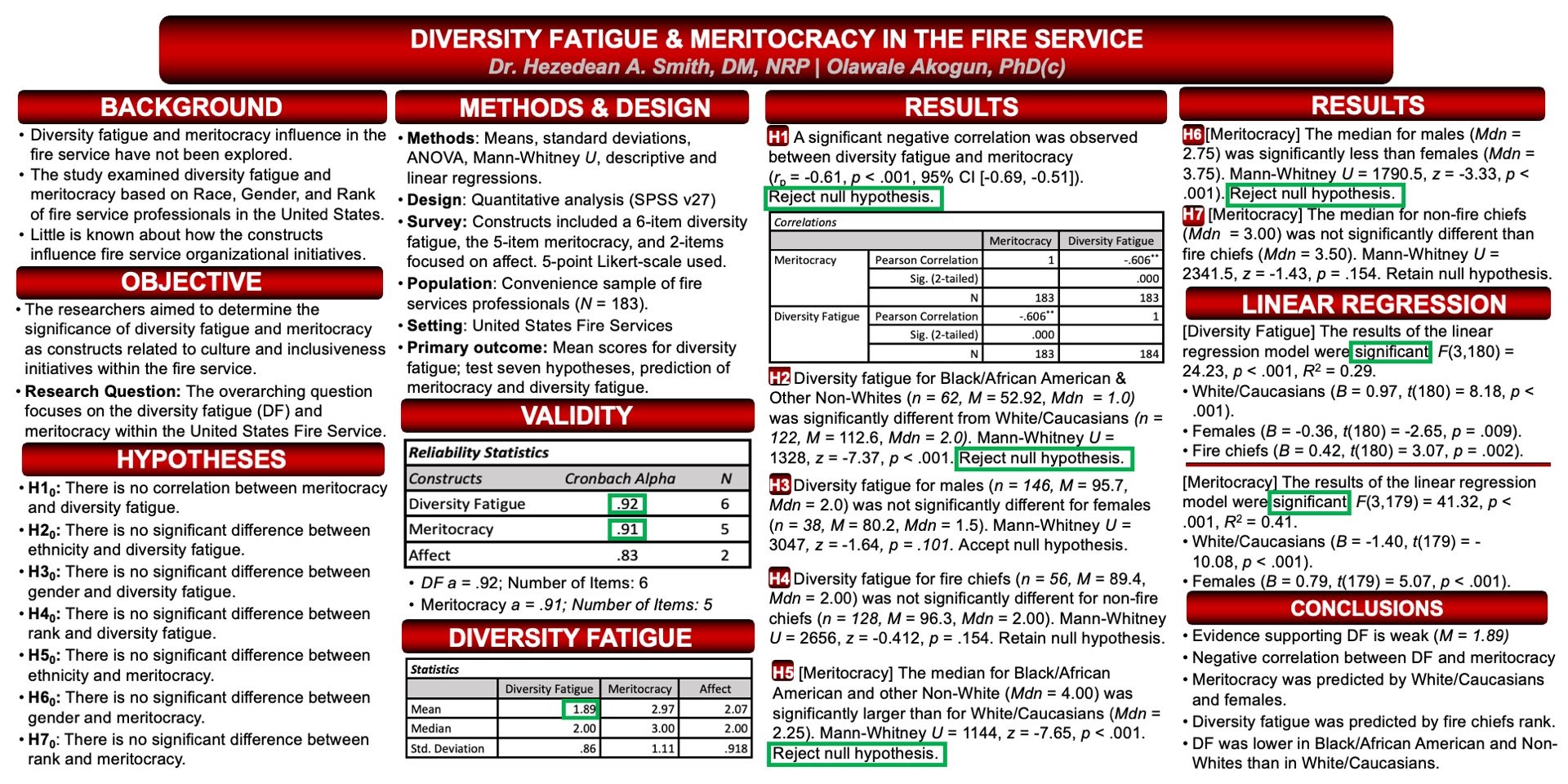
Exploration of the Fire Service
“ 🎥⚖️ How do the beliefs, emotions, and behaviors of fire service professionals shape their perceptions of diversity fatigue and the role of merit in a high-performance culture? ”
— Dr. Hezedean A. Smith
Quick Clips
Introduction
This study explored the concepts of diversity fatigue (DF) and meritocracy within the context of fire service professionals in the United States, focusing on the effects of race, gender, and rank on these constructs. The research aimed to uncover how diversity fatigue correlated with meritocratic views in fire service personnel, shedding light on how these factors influenced organizational culture and inclusivity initiatives.
Methods
A quantitative methodology was employed, utilizing data collected through a SurveyMonkey™ questionnaire distributed to a purposeful sample of fire service professionals. Participants were asked to respond based on a 5-point Likert scale. The study employed SPSS™ (version 27) to conduct various analyses, including Cronbach's alpha for reliability, Spearman’s correlation, Mann-Whitney U tests, and linear regression models.
Results
Reliability Statistics
Cronbach's alpha values were assessed to ensure the internal consistency of the scales used in this study:
| Construct | Cronbach's Alpha (α) | Number of Items |
|---|---|---|
| Diversity Fatigue | 0.92 | 6 |
| Meritocracy | 0.91 | 5 |
| Affect | 0.83 | 2 |
Correlations
A significant negative correlation was observed between diversity fatigue and meritocracy (rp = -0.61, p < .001, 95% CI [-0.69, -0.51]). This indicated that as diversity fatigue increased, views on meritocracy tended to decrease.
| Constructs | Meritocracy | Diversity Fatigue |
|---|---|---|
| Meritocracy | 1 | -0.606** |
| Diversity Fatigue | -0.606** | 1 |
| Sig. (2-tailed) | .000 | .000 |
| N | 183 | 184 |
Descriptive Statistics
Mean, median, and standard deviation scores for the constructs:
| Construct | Mean | Median | Std. Deviation |
|---|---|---|---|
| Diversity Fatigue | 1.89 | 2.00 | 0.86 |
| Meritocracy | 2.97 | 3.00 | 1.11 |
| Affect | 2.08 | 2.00 | 0.92 |
Subgroup Analysis: Race and Diversity Fatigue
Differences in diversity fatigue were observed across racial categories. Black/African American and Non-White respondents reported significantly lower levels of diversity fatigue (M = 1.32) compared to White/Caucasian respondents (M = 2.18), with the difference being statistically significant (U = 1328, z = -7.37, p < .001).
Subgroup Analysis: Gender and Meritocracy
A significant difference was found between male and female respondents regarding meritocracy. Female respondents had a higher median score (Mdn = 3.75) compared to males (Mdn = 2.75), with statistical significance (U = 1790.5, z = -3.33, p < .001).
Linear Regression Analysis
Diversity Fatigue:
White/Caucasians: B = 0.97, t(180) = 8.18, p < .001
Females: B = -0.36, t(180) = -2.65, p = .009
Fire chiefs: B = 0.42, t(180) = 3.07, p = .002
Meritocracy:
White/Caucasians: B = -1.40, t(179) = -10.08, p < .001
Females: B = 0.79, t(179) = 5.07, p < .001
Test of Hypotheses
The study’s hypotheses were evaluated using Mann-Whitney U tests and regression models. The results included:
- A significant negative correlation between diversity fatigue and meritocracy (H1: Reject null hypothesis).
- Significant differences between ethnicities regarding diversity fatigue (H2: Reject null hypothesis).
- No significant differences in diversity fatigue across gender (H3: Accept null hypothesis) or rank (H4: Retain null hypothesis).
- Significant differences in meritocracy by race and gender (H5, H6: Reject null hypotheses), but no significant differences by rank (H7: Retain null hypothesis).
Discussion
The results suggested a significant negative relationship between diversity fatigue and meritocracy in the fire service. Diversity fatigue was generally low among fire service professionals, with Black/African American and non-White respondents reporting the lowest levels of diversity fatigue. Conversely, meritocracy scores were higher among White/Caucasians and females, indicating that these groups were more likely to perceive meritocratic structures as effective.
Conclusion
This study contributed valuable insights into the dynamics of diversity fatigue and meritocracy within the fire service. It revealed that diversity fatigue and meritocratic views were interconnected, with significant variations based on race and gender. The research highlighted the need for further investigation into how these constructs impacted organizational culture, particularly as fire services continued to promote inclusivity and diversity.
Future research should delve deeper into how diversity fatigue and meritocracy influenced the everyday experiences of fire service professionals, and explore strategies to mitigate fatigue while fostering fair meritocratic practices across all demographics.
Authors
Hezedean A. Smith (Global Emergency Consulting Group, Gotha, Florida)
Olawale O. Akogun (University of Ibadan, Nigeria)


